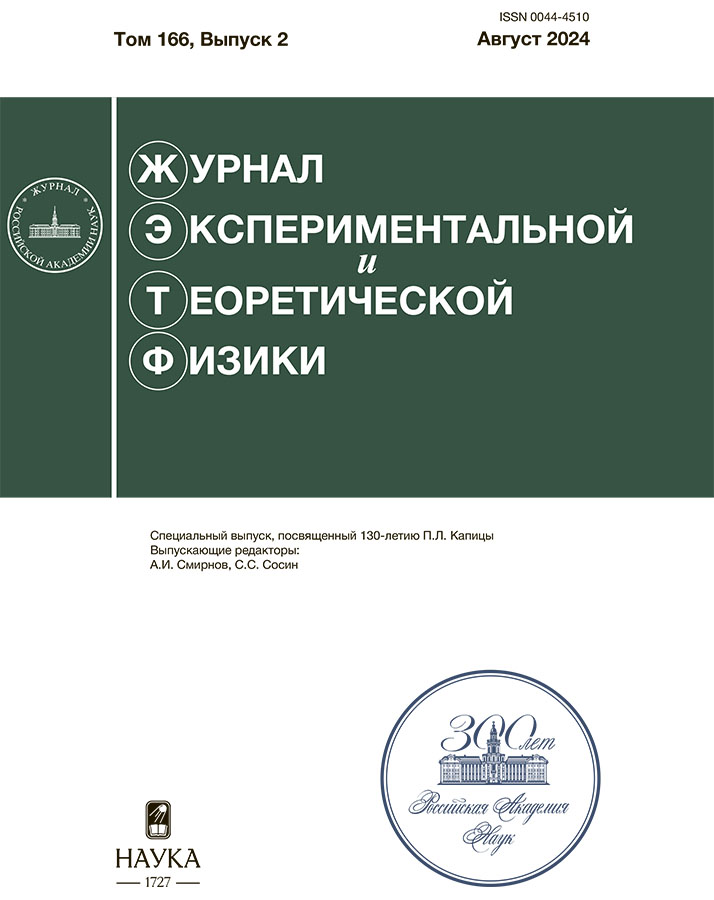VACUUM BIREFRINGENCE AND DICHROISM IN A STRONG PLANE-WAVE BACKGROUND
- Autores: Aleksandrov I.A.1,2, Shabaev V.M.1,3
-
Afiliações:
- Saint Petersburg State University
- Ioffe Physical-Technical Institute of the Russian Academy of Sciences
- National Research Centre «Kurchatov Institute», B. P. Konstantinov Petersburg Nuclear Physics Institute
- Edição: Volume 166, Nº 2 (2024)
- Páginas: 182-193
- Seção: Articles
- URL: https://rjpbr.com/0044-4510/article/view/653838
- DOI: https://doi.org/10.31857/S0044451024080042
- ID: 653838
Citar
Texto integral
Resumo
In the present study, we consider the effects of vacuum birefringence and dichroism in strong electromagnetic fields. According to quantum electrodynamics, the vacuum state exhibits different refractive properties depending on the probe photon polarization and one also obtains different probabilities of the photon decay via production of electron-positron pairs. Here we investigate these two phenomena by means of several different approaches to computing the polarization operator. The external field is assumed to be a linearly polarized plane electromagnetic wave of arbitrary amplitude and frequency. Varying the probe-photon energy and the field parameters, we thoroughly examine the validity of the locally-constant field approximation (LCFA) and techniques involving perturbative expansions in terms of the external-field amplitude. Within the latter approach, we develop a numerical method based on a direct evaluation of the weak-field Feynman diagrams, which can be employed for investigating more complex external backgrounds. The polarization operator depends on two parameters: classical nonlinearity parameter ξ and the product η = ωq0/m2 of the laser field frequency ω and the photon energy q0 (m is the electron mass). The domains of validity of the approximate techniques in the ξη plane are explicitly identified.
Sobre autores
I. Aleksandrov
Saint Petersburg State University; Ioffe Physical-Technical Institute of the Russian Academy of Sciences
Autor responsável pela correspondência
Email: i.aleksandrov@spbu.ru
Saint Petersburg, Russia; Saint Petersburg, Russia
V. Shabaev
Saint Petersburg State University; National Research Centre «Kurchatov Institute», B. P. Konstantinov Petersburg Nuclear Physics Institute
Email: i.aleksandrov@spbu.ru
Saint Petersburg, Russia; Gatchina, Russia
Bibliografia
- H. Euler and B. Kockel, Naturwiss. 23, 246 (1935).
- W. Heisenberg and H. Euler, Z. Phys. 98, 714 (1936).
- V. Weisskopf, Kong. Dans. Vid. Selsk., Mat.-fys. Medd. XIV, 6 (1936).
- R. Karplus and M. Neuman, Phys. Rev. 80, 380 (1950); 83, 776 (1951).
- F. Sauter, Z. Phys. 69, 742 (1931).
- J. Schwinger, Phys. Rev. 82, 664 (1951).
- Di Piazza, C. Muller, K. Z. Hatsagortsyan, and C. H. Keitel, Rev. Mod. Phys. 84, 1177 (2012).
- S. Xie, Z. L. Li, and S. Tang, Matter Radiat. Extremes 2, 225 (2017).
- Fedotov, A. Ilderton, F. Karbstein, B. King, D. Seipt, H. Taya, and G. Torgrimsson, Phys. Rep. 1010, 1 (2023).
- J. S. Toll, Ph.D. thesis, Princeton Univ., 1952 (unpublished).
- R. Baier and P. Breitenlohner, Acta Phys. Austriaca 25, 212 (1967).
- R. Baier and P. Breitenlohner, Nuovo Cimento B 47, 117 (1967).
- V. N. Baier, A. I. Milstein, and V. M. Strakhovenko, Zh. Eksp. Teor. Fiz. 69, 1893 (1975) [Sov. Phys. JETP 42, 961 (1976)].
- W. Becker and H. Mitter, J. Phys. A 8, 1638 (1975).
- A. Aleksandrov, A. Di Piazza, G. Plunien, and V. M. Shabaev, Phys. Rev. D 105, 116005 (2022).
- Di Piazza, K. Z. Hatsagortsyan, and C. H. Keitel, Phys. Rev. Lett. 97, 083603 (2006).
- T. Heinzl, B. Liesfeld, K. U. Amthor, H. Schwoerer, R. Sauerbrey, and A. Wipf, Opt. Commun. 267, 318 (2006).
- V. Dinu, T. Heinzl, A. Ilderton, M. Marklund, and G. Torgrimsson, Phys. Rev. D. 89, 125003 (2014).
- F. Karbstein, H. Gies, M. Reuter, and M. Zepf, Phys. Rev. D. 92, 071301(R) (2015).
- F. Karbstein and E. A. Mosman, Phys. Rev. D 101, 113002 (2020).
- F. Karbstein, Annalen Phys. 534, 2100137 (2022).
- F. Karbstein, D. Ullmann, E. A. Mosman, and M. Zepf, Phys. Rev. Lett. 129, 061802 (2022).
- F. Karbstein and R. Shaisultanov, Phys. Rev. D 91, 085027 (2015).
- S. Meuren, C. H. Keitel, and A. Di Piazza, Phys. Rev. D 88, 013007 (2013).
- S. Bragin, S. Meuren, C. H. Keitel, and A. Di Piazza, Phys. Rev. Lett. 119, 250403 (2017).
- King and N. Elkina, Phys. Rev. A 94, 062102 (2016).
- Y. Nakamiya and K. Homma, Phys. Rev. D 96, 053002 (2017).
- A. Aleksandrov, G. Plunien, and V. M. Shabaev, Phys. Rev. D 99, 016020 (2019).
- G. Sevostyanov, I. A. Aleksandrov, G. Plunien, and V. M. Shabaev, Phys. Rev. D 104, 076014 (2021).
- A. Aleksandrov, D. G. Sevostyanov, and V. M. Shabaev, Symmetry 14, 2444 (2022).
- A. Aleksandrov, D. G. Sevostyanov, and V. M. Shabaev, arXiv:2210.15626.
- H. Gies, F. Karbstein, and R. Shaisultanov, Phys. Rev. D 90, 033007 (2014).
- V. B. Berestetskii, E. M. Lifshitz, and L. P. Pitaevskii, Quantum Electrodynamics (Elsevier Butterworth-Heinemann, Oxford, 1982).
- A. Batalin and A. E. Shabad. FIAN Preprint 166, (1968).
- N. B. Narozhnyi, Sov. Phys. JETP 28, 371 (1969).
- V. I. Ritus, Ann. Phys. 69, 555 (1972).
- V. I. Ritus, J. Sov. Laser Res. 6, 497 (1985).
- A. Aleksandrov and V. M. Shabaev, Optics and Spectroscopy 129, 890 (2021).
- A. Aleksandrov, G. Plunien, and V. M. Shabaev, Phys. Rev. D 100, 116003 (2019).
Arquivos suplementares










